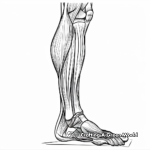All of the coloring pages displayed on this page are free for personal use (view full use policy). Any brands, characters, or trademarks featured in our coloring pages are owned by their respective holders and depicted here as fan art.
Please enjoy these muscle anatomy coloring pages!
Detailed Muscular System Coloring Pages




Skeletal Muscle Coloring Pages




Smooth Muscle Anatomy Coloring Sheets




Intricate Cardiac Muscle Coloring Pages




Easy-to-Color Arm Muscle Coloring Pages




Hand Muscle Anatomy Coloring Pages




Abdominal Muscles Coloring Sheets




Advanced Leg Muscle Coloring Pages for Adults




Simple Foot Muscle Coloring Pages for Children




Muscles of the Back: Detailed Coloring Pages




Neck Muscle Anatomy Coloring Pages




Chest Muscle Coloring Pages for Anatomical Study




Glute Muscles Coloring Pages: Detailed Anatomy




Muscles of the Face Coloring Pages




Shoulder Muscles Coloring Pages for Learning Anatomy




Tips For Coloring Muscle Anatomy Coloring Pages
What colors should I use for muscle anatomy coloring pages?
For muscle anatomy coloring pages, it would be beneficial to use a range of reds, pinks, and whites to depict various muscle types and different stages of muscle contraction. Darker shades of red can represent the denser muscles while lighter shades could display less dense muscle parts. Whites and creams can represent tendons and ligaments.
How can I add more detail and realism to my muscle anatomy coloring?
To add detail, you can use darker and lighter shades to emphasize muscle depth and perspective. You could also use gradients and shading to show muscle fibers and tissues. Start with lighter shades for the base and gradually add darker shades for depth and contouring. Remember to highlight areas where tendons connect to muscles with appropriate coloring.
What are some interesting features of muscle anatomy I should pay attention to while coloring?
Pay attention to the striations in the muscles which are a series of ridges or linear marks that run perpendicular to the muscle fibers. These provide texture and depth. Also, it might be interesting to note the difference in shape and size between various muscle types. For example, smooth muscles are spindle-shaped while skeletal muscles are long and cylindrical.
Can you provide some interesting facts about muscle anatomy that I could incorporate into my art?
Absolutely, there are over 600 muscles in the human body and different types of muscles have different functions. For instance, striated muscles help in voluntary movements, whereas smooth muscles assist in involuntary activities like digestion. Cardiac muscles are responsible for the heartbeat. Also, the smallest muscle in the body is in the ear and the largest is the buttock muscle. Incorporating these facts could add interest and educational value to your illustrations.
Related Coloring Pages
About Our Coloring Pages
All of the coloring pages displayed on this page are free for personal use. You have our express permission to download, print, color, and enjoy these pages at your own leisure and convenience. Each piece of artwork on this page has been chosen to inspire creativity and make the world of coloring engaging and enjoyable for all age groups. This permission extends to small non-commercial group settings like classrooms or therapy settings - you have our permission to print these for free distribution to small groups.
This permission is granted strictly for non-commercial uses. These images can not be resold, republished, or used for commercial purposes in any form or method. You may not sell the final colored versions, or use them as design elements in a product that is sold. Please contact us for commercial licensing options.
Our priority is to support and inspire creativity among those who love to color. Please join us in honoring this purpose by adhering to these guidelines. Happy Coloring!
